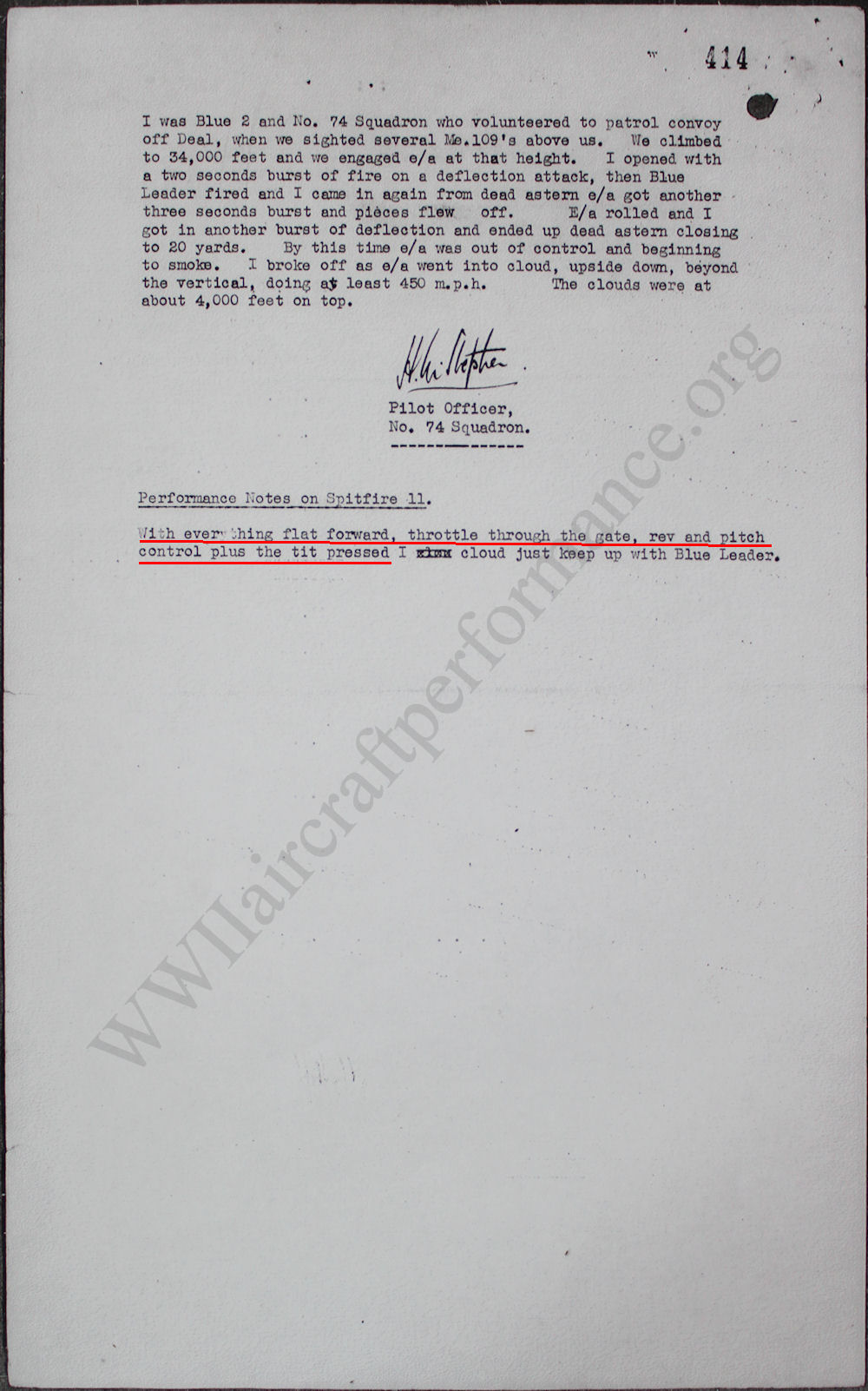
 |
|
|||||||
| IL-2 Sturmovik: Cliffs of Dover Latest instalment in the acclaimed IL-2 Sturmovik series from award-winning developer Maddox Games. |
 |
|
|
Thread Tools | Display Modes |
|
#51
|
||||
|
||||
|
Quote:
 Much better to have a massive advantage to blue in speed, climb, roll, firepower and dive right? |
|
#52
|
||||
|
||||
|
Quote:
The damage to longevity was done when still flying by the book and using overboost. Btw, the Luftwaffe did change a 109 engine in the field in 15 minutes, the RAF took a day, iirc.
__________________
Win 7/64 Ult.; Phenom II X6 1100T; ASUS Crosshair IV; 16 GB DDR3/1600 Corsair; ASUS EAH6950/2GB; Logitech G940 & the usual suspects  |
|
#54
|
||||
|
||||
|
I thought the RAF were still replacing engines in Spitfires and Hurricanes? There's a race on to be the first one done. It's the main reason there are so few left flying today actually.
__________________
Pilot #1 (9:40 hours flying time, 3/0/1 Fighters, 7/2/0 Bombers). RIP No.401 Squadron Forum    Using ReconNZ's Pilot Log Book |
|
#55
|
|||
|
|||
|
Hi Guys,
Fwiw, a couple of Spitfire II combat reports from 74 Squadron noting use of boost cut out & throttle through the gate in combat. Sgt. N. Morrison, Spitfire II, 74 Squadron, 2 November 1940  P/O H. M. Stephen, Spitfire II, 74 Squadron, 30 November 1940 
|
|
#56
|
|||
|
|||
|
Excellent! Two references which really clarify the Spit II boost operation:
Quote:
Lane: Those are very useful combat reports. Even though it contradicts my idea that the +12psi was delivered through main throttle operation Although the gate can only give any benefit at low level, the second report re-inforces my idea that pilots might use it "just in case" at any level. In this case the pilot pulled his boost tab, gated the throttle at maximum rpm, and felt re-assured that he was getting maximum performance! Very interesting that a Spit pilot would refer to pushing the red boost override tab as "pressing the tit" (second report). Although the Hurricane boost cutout is much more, err, breast like I guess it was just too enjoyable a reference for Spit pilots to not take up too. It starts to explain how those terms get so jumbled up in combat reports. Lastly, the second report suggests that he can only just keep up with his leader using all boost enhancements available in his MkII. What is blue leader flying if Blue 2 is writing "performance notes on the MkII" and suggesting he had to go all out to keep up? A MkI +12psi? This seems rather intriguing to me! Cheers, camber |
|
#57
|
|||
|
|||
|
"Lastly, the second report suggests that he can only just keep up with his leader using all boost enhancements available in his MkII. What is blue leader flying if Blue 2 is writing "performance notes on the MkII" and suggesting he had to go all out to keep up? A MkI +12psi? This seems rather intriguing to me!"
I guess the lead was maxed out as well. The convention is the lead would in normal circumstances give the wingman a "bit to play with" by setting a slightly reduced power setting. In a combat tail chase I guess the formation protocols were overlooked. "Pressing the Tit" is a pretty common (for 40's and 50's" bit of Brit slang for pushing or pressing any button or catch. |
|
#58
|
|||
|
|||
|
Quote:
Quote:
|
|
#59
|
|||
|
|||
|
Hi Gentlemen
Quote:
Quote:
Quote:
For the sake of argument I will state that at sea level, +12.5 psi boost is given at 60% throttle valve opening (real percentage unknown). The rated boost setpoint is +9psi, +12psi emergency with red tab pulled. The pilot takes off with pilot throttle through the gate. The boost controller piston senses that boost is too high (>9psi) and is against "boost too high" rearward stop. But the gated throttle extension pulls the throttle valve to 60% open giving +12.5 psi. As plane climbs initially, boost remains >9psi so the boost controller piston remains stuck on the "boost too high" stop. If the pilot throttle is kept gated, the resulting 60% throttle valve opening corresponds to less and less boost with height, and finally boost decreases until it is under +9psi. At that point the boost controller piston has a job to do. It moves away from the "boost too high" stop, opens the throttle valve further (i.e. > 60%) and then keeps increasing it with height to maintain +9psi boost. At 100% throttle valve opening it has reached FTH for +9psi, the boost controller piston is at the "boost too low" stop and boost starts decreasing with more altitude. At a "combat" height where the boost controller already has throttle valve opening >60% while maintaining +9psi (i.e above the effective take off boost height), what would happen if a pilot seeking more power suddenly goes through the gate? Effectively nothing, as boost would remain at +9psi. But actually, boost would momentarily rise (how much depending on mechanical dynamic constraints on the control system). The boost rise would be momentary because the boost controller piston would react by moving closer to the "boost too high" stop in order to override the gate input and return the boost to +9psi. The only difference afterwards is that inside the boost controller, the piston is at a different position than before. If the red tab is pulled, the same applies but the +9psi is instead +12psi. So my take is generally the boost controller wins, not the gate. The documentation states the take off boost is ineffective over low altitude, but does not warn of adverse consequences if it is used higher. So I still think it is just ineffective and going through the gate is fine in combat (but make sure you pull the red tab, that IS important!). Cheers, camber |
|
#60
|
|||
|
|||
|
Quote:
I don't know what the benefit would be of operating the boost cut-out above full throttle height. I wouldn't think there would be any benefit, but this is far from being the only instance where I've heard of it - beats me. Blue I in this instance was also operating a Spitfire II. The notable thing, I think, is that the engagement opened with the Spitfires climbing from 29,000 ft. up to 34,000 ft. to attack the Me 109s. Blue 1 was certainly aggressive and confident in his abilities as well as the capabilities of his aircraft as he initiated combat, disadvantaged both in numbers and altitude. I could well imagine Blue I giving the Spitfire everything it had, with Blue 2 doing his best to keep up. Pretty good team work it seems to me and nicely done. F/Lt. J. C. Mungo-Park, Spitfire II, 74 Squadron, 30 November 1940  As an aside, I've encountered a number of Battle of Britain accounts where the pilots would engage the boost cut-out as part of a routine preparation for the possibility of combat, for example: Geoffrey Wellum, 92 Squadron: Things are starting to get rough. Automatically I have followed my self-imposed drill that I always do at times like this. Reflector sight on; gun button to fire; airscrew pitch to 2,650 revs; better response. Press the emergency boost override. Lower my seat a notch and strap tight. Ok men, I’m all set. Let battle commence.P/O David Crook, 609 Squadron : It was now obviously a matter of moments only before we were in the thick of it. I turned my trigger on to 'Fire', increased the engine revs. to 3000 r.p.m. by slipping the constant speed control fully forward, and 'pulled the plug', i.e. pushed the small handle on the throttle quadrant that cuts out the automatic boost control thus allowing one to use emergency power.Bob Doe, 234 Squadron Once we were in the vicinity of the enemy, I would 'pull the plug', which was the release so that we could get extra boost, but I wouldn't use it, and would start my search.Tom Neil, 249 Squadron The familiar stomach-clenching tension and surging wave of excitement. Another check around. Gun-sight on? Gun-button to 'Fire'? Plug pulled and 2,850 revs?K. W. McKenzie, 501 Squadron Climbing to gain some height we 'bustered' with the sun behind us and spotted the formations. With the tit pulled for absolute full power we broke formation to attack, sights 'on', guns to 'fire', harness tight, attacking individually. |
 |
|
|